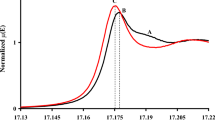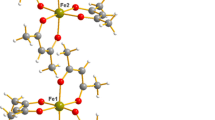Abstract
Pyridine-2,4-dicarboxylic acid (lutidinic acid) is next one after pyridine-2,5-dicarboxylic acid of the six isomers which lanthanide complexes were studied thermally and spectrally. New complexes synthesized with light lanthanides (III) with general formula Ln2L3·nH2O, where n = 7.5; 8; 8.5; 9, were obtained. Sodium salt was obtained as hexahydrated compound. Hydrated complexes of La(III), Ce(III), Pr(III), Nd(III), Sm(III), Eu(III), and Gd(III) are thermally stable up to 303–313 K. Dehydration process run for all compounds in one stage, anhydrous compounds decompose through appropriate light lanthanides (III) oxalates, oxocarbonates, carbonates to metal oxides. Theoretical IR and Raman studies were carried out in order to identify precisely characteristic group bands vibrations present on IR and Raman spectra.













Similar content being viewed by others
References
Bourgeois J, Pierson LA. Application of thermal analysis to the study of lipidic drug producing incorporation into nanocarriers. J Therm Anal Calorim. 2009;98:65–71.
Barszcz B, Masternak J, Surga W. Thermal properties of Ca(II) and Cd(II) complexes of pyridinedicarboxylates. Correlation with crystal structures. J Therm Anal Calorim. 2010;101:633–9.
Sileo EE, Rigotti G. Kinetic study of the thermal dehydration of copper(II) dipicolinates: crystal and molecular structure of Cu(II) (pyridine 2,6-dicarboxylato) DI- and Trihydrated. J Phys Chem Solids. 1997;58:1127–35.
Sileo EE, Blesa MA, Rigotti G. The crystal chemistry of copper(II) dipicolinates. Polyhedron. 1996;15:4531–40.
Sileo EE, Elsa E, Rigotti G. Solid-state coordination chemistry of pyridinedicarboxylic acid isomers. II. Crystal and molecular structure of sodium bis(pyridine-2, 4-dicarboxylato)cuprate(II) trihydrate. Acta Chem Scand. 1999;53:535–41.
Suga T, Okabe N. l-histidinol phosphate tetrahydrate. Acta Crystallogr Sect C. 1996;52:134–6.
Sileo EE, Vega D. Solid state coordination chemistry of pyridinedicarboxylic acid isomers. I copper(II) disodium Bis(pyridine-2,3- dicarboxylate) octahydrate and copper(II) pyridine-3,4-dicarboxylate 3·5 hydrate. Aust J Chem. 1999;52:205–12.
Sienkiewicz-Gromiuk J. Widma doświadczalne i teoretyczne (IR, Ramana) kwasu 4,4′-bifenylodikarboksylowego. Nauka i Przemysł. UMCS University, Lublin; 2009. pp. 446–9.
Łyszczek R, Mazur L. A three-dimensional coordination polymer constructed from sodium(I) ion and benzene-1,2,4-tricarboxylate ligand: thermal, structure and spectroscopic characteristics. Inorg Chem Commun. 2008;11:1091–3.
Rzączyńska Z. The crystal structure of a Terbium(III) complex with 1,1-cyclobutanedicarboxylic acid. J Coord Chem. 2003;56:1525–30.
Min D. Yoon SS. One dimensional copper-pyridine-dicarboxylate polymer containing square-planar Cu(II) centers exhibiting antiferromagnetic coupling. Inorg Chim Acta. 2001;324:293–9.
Dette AC, Watzig H. Characterisation of the important pharmaceutical intermediate pyridine-2,4-dicarboxylic acid using capillary electrophoresis (CE). Pharmazie. 1993;48:276–80.
Taguchi H, Koyama S. A new fluoromeric assay metod for guinolinic acid. Anal Biochem. 1983;131:194–7.
Taguchi H, Maeda M. Effects of cinchomeronic acid and related compounds on the growth of radish [Raphanus sativus] seedlings. Biosci Biotechnol Biochem. 1992;56:1921–3.
Tochikubo K, Hachisuka Y. Properties of glucose dehydrogenase from vegetative cells of Bacillus subtilis and effect of dipicolinic acid and its chemical analogues on the enzyme. Jpn J Microbiol. 1968;12:435–40.
Hachisuka Y, Tochikubo K. The action of dipicolinic acid and its chemical analogues on the heat stability of glucose dehydrogenase of Bacillus subtilis spores. J Biol Chem. 1967;61:659–61.
Setlow B, Setlow P. Dipicolinic acid greatly enhances production of spore photoproduct in bacterial spores upon UV irradiation. Appl Environ Microbiol. 1993;59:640–3.
Gerhardt P. Marquis RE. Regulation of Procaryiotic Development, American Society for Microbiology, Washington DC, Chapt. 2;1989.
Borawska MH, Koczoń P, Piekut J. Vibrational spectra and antimicrobial activity of selected bivalent cation benzoates. J Mol Struct. 2009;919:284–9.
Noro SI, Miyasaka H. Framework control by a metalloligand having multicoordination ability: new synthetic approach for crystal structures and magnetic properties. Inorg Chem. 2005;44:133–46.
Noro SI., Kitagawa S. New microporous coordination polymer affording guest-coordination sites at channel walls. Chem Commun. 2002;3:222–3.
Gerrard LA., Wood PT. Hydrothermal crystal engineering using hard and soft acids and bases: synthesis and X-ray crystal structures of the metal hydroxide-based phases M3M′2(OH)2[NC5H3(CO2)2-2,4]4(H2O)4 (M=Co, Ni, Zn; M′=Pd, Pt). Chem Commun. 2000;21:2107–8.
Liang YC, Cao R. Syntheses and characterizations of two novel Ln(III)–Cu(II) coordination polymers constructed by Pyridine-2,4-dicarboxylate ligand. Inorg Chem Commun. 2002;5:366–8.
Rzączyńska Z. Synthesis and characterization of Co(II), Cu(II) and Zn(II) complexes with 1,1-cyclobutanedicarboxylic acid. Polyhedron. 2006;25:687–94.
Rzączyńska Z, Belsky VK. Crystal structure of dimer tetraaquabis(μ-4-aminobenzoato-O, O′)tetrakis(4-aminobenzato-O, O)diytterbium (III) dihydrate. Pol J Chem. 1994;68:309–19.
Rzączyńska Z, Belsky VK. Crystal structure of triaquatris(3,5diaminobenzoato-O, O)samarium (III). Pol J Chem. 1994;68:369–75.
Yue Q. Three-dimensional 3d–4f heterometallic coordination polymers: synthesis, structures, and magnetic properties. Inorg Chem. 2005;44:5241–6.
Rzączyńska Z. The crystal structures of two neodymium(III) complexes with pyridine‐2,6‐dicarboxylic acid. J Coord Chem. 1998;43:321–34.
Brzyska W, Ożga W. Preparation, properties and thermal decomposition of Y(III) and lanthanide(III) pyridine-2,5-dicarboxylates. Termochim Acta. 1996;288:113–21.
Wasylina L, Kucharska E. The 13C NMR, UV and IR absorption spectra of pyridinedicarboxylic acids. Chem Heterocycl Compd. 1999;35:186–94.
Rzączyńska Z, Danczowska-Burdon A. Thermal and spectroscopic properties of light lanthanides (III) and sodium complexes of 2,5-pyridinedicarboxylic acid. J Therm Anal Calorim. 2010;101:671–7.
Author information
Authors and Affiliations
Corresponding author
Rights and permissions
About this article
Cite this article
Rzączyńska, Z., Danczowska-Burdon, A. Thermal and spectroscopic studies of sodium and light lanthanide (III) complexes with 2,4-pyridinedicarboxylate anion. J Therm Anal Calorim 108, 991–999 (2012). https://doi.org/10.1007/s10973-011-1986-7
Published:
Issue Date:
DOI: https://doi.org/10.1007/s10973-011-1986-7




